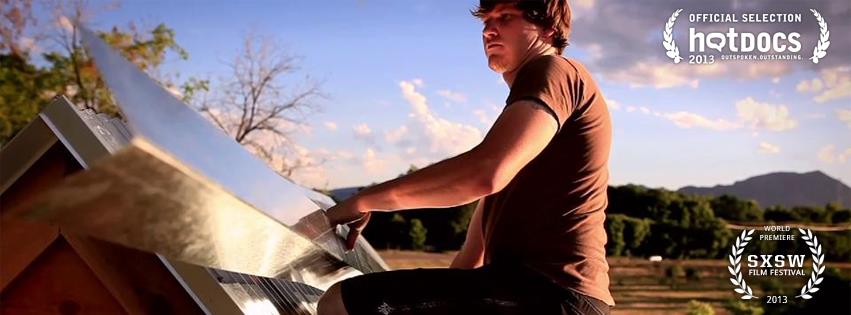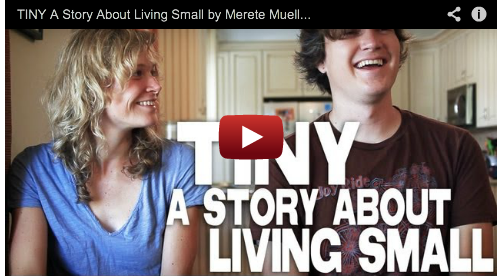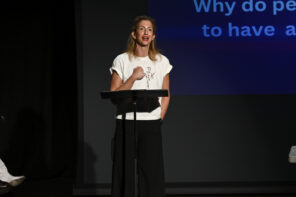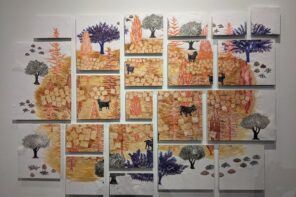TINY: A Story About Living Small hits the nail on the head
ORANGE COUNTY, CA – Henry Thoreau once said, “I went to the woods because I wished to live deliberately, to front only the essential facts of life, and see if I could not learn what it had to teach, and not, when I came to die, discover that I had not lived.” Trade out query on the existentialism of the individual for (wo)man’s search for meaning in the crowded hubbub of a townhouse living room, and you have the overarching theme touched upon in Christopher Smith and Merete Mueller’s 2013 documentary hit TINY: A Story About Living Small, which could arguably be considered the basis for a question we all ask ourselves: what makes a home? For some, it’s where “the heart is”. Others, it might just be a matter of economic convenience. But from the very beginning of their journey, Smith and Mueller challenge the viewer to suspend these notions in favor of a rudimentary crash course in soul-searching.
TINY, which premiered at the SXSW festival in early March of 2013, follows the filmmakers’ journey toward self-discovery when Smith decides one day that he’s going to build a tiny home on a trailer that he can then haul out into the middle of a plains-area (of which he owns some property) and live “the simple life.” Although the internet and research tell him otherwise, Smith optimistically predicts that construction will be completed by the end of the summer. It’s the perfect storm, really; with zero experience in architecture, low availability of funds, and sporadic help from friends and family (the majority of which appears to come from Mueller, screenwriter, co-director, and girlfriend) the magnitude of what he’s trying to accomplish becomes all too clear when days stretch into weeks, which stretch into months, and far beyond “summer project” expectations.
TINY is shot with the quiet efficiency of Smith’s inexperienced hand, appearing to us as anything but. Lush landscapes, inviting spaces, and the depthless dexterity with which the camera is handled, all contribute to an experience that is one-parts bewilderment and two-parts awe-inspiring. I don’t pretend to know anything about architecture (indeed, the Orange Film Series has been quite the lesson plan), but going in I couldn’t help but succumb to the all too naïve hold-my-beer notion that it “couldn’t be that difficult.” However, where many films, with much longer run times, are edited in such a way that building a house might seem like the easiest thing in the world, at no point does Smith and Mueller’s TINY give such an impression. To sum up best, one could say that the construction of a “tiny” house is not so much to establish a place of living as it is to uncover what it means to be “home”, to find one’s identity in the folds of wallpaper lining the four corners of a room, more often than not the only room. That being said, there is a lot of work that goes into those four walls; not once do the filmmakers hold our hands and Rocky-montage the audience through the roughest parts of construction, which, I’ll tell you now, make up almost 70% of the feature.
Perhaps this idea of identity is no more apparent than in the smattering of interviews shown throughout TINY. Men and women, couples and lone tenants, from around the country treat audiences not only to a delectable assortment of myriad styles and furnishings within and throughout their idyllic homesteads, but also describe with intuitive candor the various journeys that brought them toward the decision to go from 2,000 sq. ft. “mansions” to abodes as small as 86 sq. ft. The answers obviously varied from person to person, but one sentiment that stuck with me was that, when the home was downsized, the world seemed to get a lot bigger. I think that’s a very interesting notion, especially in an age where almost every person has access to a computer connecting them to anyone else in the world at any given time. But when you break out of that mold, as many of these interviewees have, then what you get is a cathartic-like renewal of self-awareness. That is, a second chance to find out what you’re made of, the type of person you want to be, or, better yet, the person you didn’t realize you already were.

In this vein, one type of theme that seems to pop up a lot in TINY is the notion of re-imagining the American Dream. We all know about the hokey nuclear family set-up of husband, wife, two kids, dog, and white picket fence. Personally, I think that’s changed with society taking on a much more progressive role (e.g. single mothers and divorced parents are much more commonplace, women being just as likely as men to be the breadwinners). What hasn’t changed, however, is society’s innate desire for consumption, to have “more” of everything; to over-indulge. TINY, itself a “green” micro-sized display of cinematic power clocking in at just over an hour, undermines this supposed need by showing over and over again practical living at a tenth of the space, cost, and maintenance of the house you’re probably inhabiting as you read this. What if you need to get away from your significant other for an hour and can’t because the living room is also the dining room and the kitchen? Go outside for a walk (cue gasps).
It’s important to understand that with TINY, you aren’t really watching a film about a young man’s trials and tribulation in trying to build a tiny house in the span of a few months, but rather witnessing what the culmination of all the hard work will mean for him and, more importantly, for the viewer, society itself. About a third of the way through the film, Smith realizes that construction of the tiny house will take much longer than his three-month conjecture. While many—including myself—might’ve lost the initial driver that carried them into the project, acquiescing to life as is, Smith and Mueller carry on with a proficient disregard for the ensuing thunderstorms, snowfall, heat, and personal misgivings, to find a self in all the dirt, wood, and grime. It is, without stepping too far into romanticism, a truly inspiring transformation to behold.
So to touch on the question I offered at the beginning, as to what makes a home, the film makes it clear that the answer is different for everyone, but that it might not necessarily be what you would initially guess. One interviewee puts it best when she says that building a tiny house is one of the most difficult things you can accomplish in your life. If you watch the film, I think you’ll agree when I say she probably wasn’t referring to just the hammer and nails.
“What is home? And how do we find it? TINY follows one couple’s attempt to build a Tiny House from scratch with no building experience, and profiles other families who have downsized their lives into houses smaller than the average parking space. Through homes stripped down to their essentials, the film raises questions about sustainability, good design, and the changing American Dream.” [IMDB]
The Orange County Museum of Art is located in Newport Beach, near Fashion Island, at 850 San Clemente Dr., Newport Beach, CA 92660. Hours for the museum are: MON-TUES, closed; WED-SUN, 11:00am-5:00pm; THUR, 11:00am-8:00pm.
Now in its tenth season celebrating the cinematic works and of emerging and established independent filmmakers, OCMA and the Newport Beach Film Festival present the 2014 Cinema Orange film series. Films will explore art, design and cultural icons. Interactive question and answer sessions with filmmakers will follow select screenings. Cinema Orange is organized by Leslie Feibleman, director of special programs and community cinema, Newport Beach Film Festival.
Follow ATOD Magazine™
This article brought to you by our friends at:







